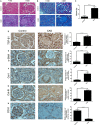Role of endothelial-to-mesenchymal transition induced by TGF-β1 in transplant kidney interstitial fibrosis
- PMID: 28374926
- PMCID: PMC5618680
- DOI: 10.1111/jcmm.13157
Role of endothelial-to-mesenchymal transition induced by TGF-β1 in transplant kidney interstitial fibrosis
Abstract
Chronic allograft dysfunction (CAD) induced by kidney interstitial fibrosis is the main cause of allograft failure in kidney transplantation. Endothelial-to-mesenchymal transition (EndMT) may play an important role in kidney fibrosis. We, therefore, undertook this study to characterize the functions and potential mechanism of EndMT in transplant kidney interstitial fibrosis. Proteins and mRNAs associated with EndMT were examined in human umbilical vein endothelial cells (HUVECs) treated with transforming growth factor-beta1 (TGF-β1) at different doses or at different intervals with western blotting, qRT-PCR and ELISA assays. Cell motility and migration were evaluated with motility and migration assays. The mechanism of EndMT induced by TGF-β1 was determined by western blotting analysis of factors involved in various canonical and non-canonical pathways. In addition, human kidney tissues from control and CAD group were also examined for these proteins by HE, Masson's trichrome, immunohistochemical, indirect immunofluorescence double staining and western blotting assays. TGF-β1 significantly promoted the development of EndMT in a time-dependent and dose-dependent manner and promoted the motility and migration ability of HUVECs. The TGF-β/Smad and Akt/mTOR/p70S6K signalling pathways were found to be associated with the pathogenesis of EndMT induced by TGF-β1, which was also proven in vivo by the analysis of specimens from the control and CAD groups. EndMT may promote transplant kidney interstitial fibrosis by targetting the TGF-β/Smad and Akt/mTOR/p70S6K signalling pathways, and hence, result in the development of CAD in kidney transplant recipients.
Keywords: Akt/mTOR/p70S6K; Smad; chronic allograft dysfunction; endothelial-to-mesenchymal transition; kidney interstitial fibrosis; kidney transplantation; transforming growth factor-beta1.
© 2017 The Authors. Journal of Cellular and Molecular Medicine published by John Wiley & Sons Ltd and Foundation for Cellular and Molecular Medicine.
Figures







References
-
- Heemann U, Lutz J. Pathophysiology and treatment options of chronic renal allograft damage. Nephrol Dial Transplant. 2013; 28: 2438–46. - PubMed
-
- Nankivell BJ, Borrows RJ, Fung CL, et al The natural history of chronic allograft nephropathy. N Engl J Med. 2003; 349: 2326–33. - PubMed
-
- Campistol JM, Boletis IN, Dantal J, et al Chronic allograft nephropathy–a clinical syndrome: early detection and the potential role of proliferation signal inhibitors. Clin Transplant. 2009; 23: 769–77. - PubMed
Publication types
MeSH terms
Substances
LinkOut - more resources
Full Text Sources
Other Literature Sources
Medical
Miscellaneous

